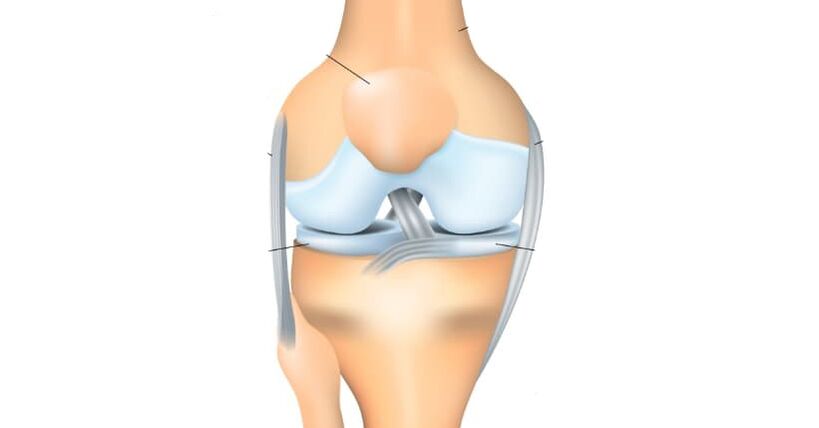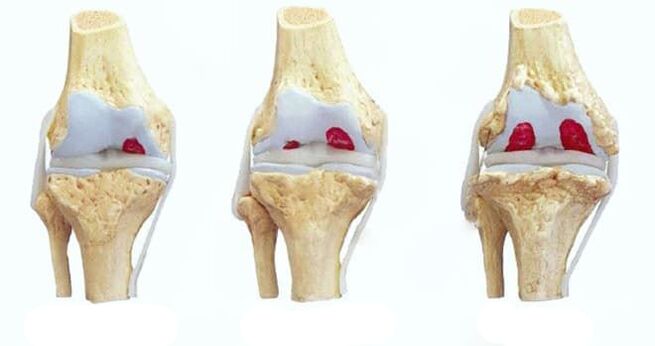A disease of non-infectious origin, in which the hyaline cartilage of the knee joint suffers first of all, eventually collapses and stops performing its function, and then leads to the destruction of other components of the joint and its development. deformation.
This degenerative-dystrophic disease, as a rule, occurs in women after the age of 40, but men can also suffer, especially those who are overweight, often prone to hypothermia, engaged in active sports or due to injury.
Among all arthrosis, gonarthrosis of the knee joint is the most common.
There is an opinion that the cause of gonarthrosis is the deposition of salts in the joint. This idea is completely wrong, and the deposition of salts is more of a secondary process and causes pain during the development of the disease and is localized at the points of attachment of tendons and ligaments. Prevention plays an important role in disease prevention.
Anatomy of the knee joint

The knee joint consists of two surfaces formed by the tibia and the femur. At the front, the knee joint protects the patella, which moves between the condyles of the femur. The fibula is not involved in the formation of the knee joint and essentially carries no functional load, so it is often used to reconstruct other bony elements in the body.
All joint surfaces: the inner surface of the tibia, femur and patella are covered with hyaline cartilage, the texture is very smooth, it has high strength and elasticity, the thickness of this dense and elastic structure reaches 5-6 mm. Cartilage absorbs the cushion during physical activity, prevents friction and softens the impact.
Classification of gonarthrosis
From the point of view of origin, gonarthrosis can be classified as primary, manifestation, arising from injury and secondary development, provoked by trauma, disease or developmental pathology, and often occurs unilaterally. In this case, the first type of gonarthrosis, as a rule, occurs in older people and is rarely unilateral.
In its development, arthrosis of the knee joint goes through the following stages:
- The first stage of gonarthrosis- does not cause significant pain to the patient, it is characterized by intermittent aching or stretching pain, especially after heavy physical training or direct loading on the knee joint. The so-called "starting pain" symptom appears, when the patient suddenly stands up, painful sensations appear, gradually disappear, but if an increased load is applied to the limb, the pain starts again. Slight swelling may occur on its own. Rarely, but it happens, synovitis - fluid accumulates in the articular bag of the knee, due to which the knee area becomes spherical and swollen, movements in the limbs are limited. At this stage, there is still no deformation of the joint.
- The second stage- the patient begins to suffer from long and rather severe pains in the front and inner side of the joint, even with small loads, but it usually disappears after a long rest. When the joint moves, creaking is heard, and if the patient tries to bend the limb as much as possible, sharp pain occurs. The amplitude of the movement of the joint is limited, the deformation begins to be detected. Synovitis often occurs, bothers for a longer time, continues with a large accumulation of joint fluid.
- The third stage- causes considerable suffering to the patient, the pain is constant and bothers not only during walking, but also during rest and even at night, preventing sleep. The joint is already significantly deformed, the position of the limb becomes X or O-shaped. A predatory gait appears, and often, due to significant deformation, a person not only cannot bend, but also opens his leg completely, as a result, he has to use a cane or even crutches to walk.
Pathology of gonarthrosis of the knee joint

- In the initial, first stage of gonarthrosis, due to the development of the pathological process in the vessels supplying intraosseous hyaline cartilage, the articular surfaces gradually lose their characteristics. They begin to dry, lose their smooth texture, cracks appear, as a result of which the sliding of the articular surfaces is disturbed, they begin to stick together, and surface defects increase. Hyaline cartilage degenerates, loses its shock-absorbing function due to constant microtraumas.
- In the second stage of gonarthrosis, degenerative-dystrophic manifestations increase: the joint space narrows, the articular surfaces are smoothed, and they adapt to increased loads. The part of the bone adjacent to the hyaline cartilage of the joint is denser, and osteophytes appear along its edges in the form of growth of bone tissue. The capsule of the knee joint also undergoes changes by losing its elasticity. The fluid inside the joint becomes thicker and more viscous, changing its nutritional and lubricating properties, which further impairs joint function. Due to malnutrition, the condition of hyaline cartilage worsens, it begins to break down and in some places it disappears completely. As a result of increased friction, degeneration of the knee joint increases progressively, which leads to the third stage of gonarthrosis.
- In the third stage of gonarthrosis, there is a clear limitation of the range of motion in the joint. Surfaces are significantly deformed, hyaline cartilage is practically absent, bones seem to be pressed together.
Reasons for the development of gonarthrosis
In fact, it is impossible to determine any cause of gonarthrosis. Basically, its occurrence is caused by a combination of a number of reasons and various internal and external factors.
In 20-30% of cases, gonarthrosis is provoked by traumatic injuries of knee joints or their components (ligaments, tendons, menisci), as well as femur or tibia fractures. The disease, as a rule, manifests itself 3-5 years after the injury. However, there are cases of gonarthrosis development in the early period (2-3 months).
In some patients, gonarthrosis can occur with high physical exertion. Often, active physical activity can cause a disease, especially after 40 years, when people begin to actively exercise to maintain their health and realize the need for a healthy lifestyle. The greatest load on the joints is when running, as well as during jumping and squatting.
Excess weight can also cause the formation of gonarthrosis, especially in combination with varicose veins of the lower extremities. The load on the knee joints increases, microtraumas or even serious injuries of the meniscus or the ligamentous apparatus of the joint occur. In this case, healing is much more difficult because. it is impossible to get rid of excess weight quickly to ease the load on the joint.
There can be various types of arthritis (gout, psoriatic, rheumatoid, reactive or Bechterev's disease), some neurological pathologies (injuries of the spinal column, head injuries and other diseases caused by the disruption of the innervation of the lower limbs), as well as hereditary diseases. causes the development of gonarthrosis. causes connective tissue weakness.
Diagnosis of gonarthrosis
To diagnose a patient with gonarthrosis, a combination of complaints, examination and X-ray studies is necessary.
Today, the X-ray image of the joint is the simplest and most accessible research method, with the help of which it is possible to diagnose the patient with a sufficient degree of accuracy, to observe and determine the development of the process in dynamics. subsequent treatment tactics. Among other things, X-ray allows to make a different diagnosis, for example, to exclude a tumor process in the bone tissue of the thigh or lower leg or inflammation. Also, computed tomography and magnetic resonance imaging are used to diagnose gonarthrosis, which can show changes not only in bone structures, but also in soft tissues.
In old age, everyone has certain symptoms of gonarthrosis, so the diagnosis can be made only after complete collection of anamnestic data, complaints and visual examination, as well as instrumental research methods.
Treatment of gonarthrosis of the knee joint
When the first signs of knee joint disease appear, it is necessary to consult an orthopedic doctor as soon as possible. At the initial stage of the process, the doctor prescribes drug treatment and complete rest of the affected limb.
After the acute period has passed, it is possible to determine:
- exercise therapy course,
- massage,
- as well as physiotherapy procedures (electrophoresis with analgesics, UHF therapy, magnetic or laser therapy, phonophoresis with anti-inflammatory steroids, mud treatment, etc. )
At the next stage of treatment, the doctor can prescribe drug therapy, which involves taking chondroprotectors that stimulate joint metabolic processes. Sometimes, intra-articular injections with hormone-containing drugs are required. If the patient has the opportunity to receive sanatorium-spa treatment, it is recommended. Often, the patient is advised to use a cane while walking to relieve joint load. For prevention, you can use special orthopedic insoles or orthoses.
If the patient is diagnosed with the third stage of gonarthrosis, its manifestations are most pronounced (pain, impaired or complete failure of the joint), surgical treatment consisting of knee arthroplasty may be required. Rehabilitation measures, as a rule, last from 3 to 6 months until the joint function is fully restored, after which the patient can return to normal life.
Prevention
In order to prevent degenerative-destructive changes in the knee joint with age, it is necessary to resort to physical education, wear orthopedic shoes, control body weight, and control rest and exercise regime.



















